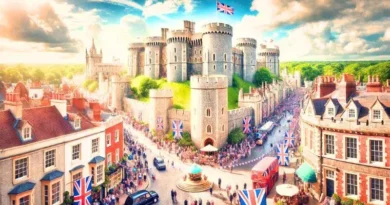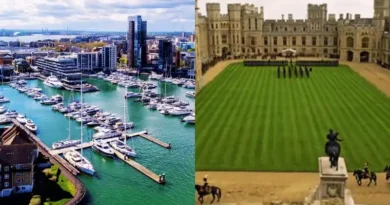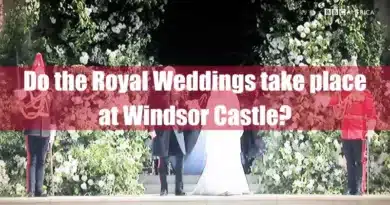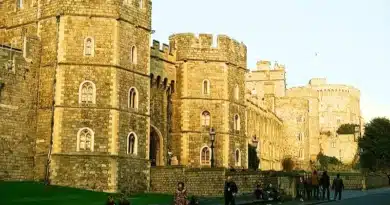Get to Windsor Castle From Nottingham
Takeaways
- Windsor Castle is approximately 100 miles (161 km) from Bristol, with a driving time of around 1 hour and 45 minutes under ideal conditions.
- The best way to get to Windsor Castle from Nottingham depends on convenience and preference. By car, the fastest and most direct route is via the M1, M25, and M4, taking approximately 2 hours 42 minutes, though traffic near London may cause delays.
- Alternative routes include the M40 (2 hours 46 minutes, 143 miles), which offers a scenic drive and avoids M25 congestion, or a hybrid M1–M40 route (2 hours 47 minutes, 137 miles) for a balanced approach.
- By train, the quickest journey takes 2 hours 53 minutes via East Midlands Railway to London St Pancras, followed by underground and a train from Slough to Windsor & Eton Central. Train travel eliminates parking concerns but may involve multiple transfers.
- For cycling enthusiasts, a long-distance 138–141-mile ride via National Cycle Routes 6, 57, or 64 takes about 12 hours and offers scenic countryside views.
- The best option is the M1–M25–M4 car route for speed and ease, but the train via London and Slough is a reliable choice for a stress-free journey.
Getting to Windsor Castle from Nottingham by Car
Routes Comparison
| Feature | Route #1: Via M1 | Route #2: Via M40 | Route #3: Via M1 & M40 |
|---|---|---|---|
| Distance | 131 miles | 143 miles | 137 miles |
| Estimated Time | 2 hrs 42 mins | 2 hrs 46 mins | 2 hrs 47 mins |
| Key Motorways | M1, M25, M4 | M1, M69, A46, M40, A404 | M1, A43, M40, A404, M4 |
| Traffic Considerations | Potential congestion near London & M25 interchange | Less congested than M1 but delays possible near Oxford & High Wycombe | Balanced approach to avoid major congestion hotspots |
| Scenic Route? | No | Yes – passes through Warwickshire & Chiltern Hills | Moderate – some scenic sections on A43 |
| Ease of Navigation | Straightforward via motorways | Slightly more complex with multiple transitions | Moderate complexity with changes between motorways |
| Best For | Fastest and most direct route | Those avoiding M1/M25 congestion, preferring scenic views | A balanced approach between speed and congestion avoidance |
This table provides a clear comparison of the three routes, helping travellers choose the best option based on their preferences. 🚗
Google Map
Route #1: Via M1
One of the fastest and most straightforward routes to Windsor Castle from Nottingham is via the M1 motorway. Under ideal driving conditions, the journey takes approximately 2 hours and 42 minutes, covering a distance of 131 miles.
Route Overview
This route follows major motorways, including the M1, M25, and M4, making it a convenient choice for travellers. Traffic conditions are typically manageable, but congestion may occur near London and the M25 interchange.
Step-by-Step Directions
- Starting in Nottingham:
- Begin on Maid Marian Way/A6008, heading southeast towards Mount St.
- Continue on Castle Blvd, then turn left onto Wilford St.
- Proceed on Queens Dr/A453, following signs for the M1 motorway.
- Merge onto Clifton Blvd/A52, then take the A453 ramp to M1/Birmingham/A42.
- Continue on Clifton Ln/A453 and follow Remembrance Way/A453 for about 5.6 miles.
- At Kegworth Interchange, take the M1 ramp towards London.
- On the M1 & M25:
- Merge onto the M1 and drive 75.9 miles south.
- At Junction 6A, take the exit for M25, following signs for Heathrow Airport.
- Continue on M25 for 18.8 miles, then merge onto the M4 at Junction 15.
- Approaching Windsor:
- Take the A4 exit from the M4, following signs for Datchet/Langley.
- Follow B470 (Major’s Farm Rd, London Rd, and High St).
- Turn onto Windsor Rd/B470, then turn left onto Thames St/B3022.
- Continue onto Castle Hill, where Windsor Castle will be located ahead.
Travel Tips
- Peak Traffic Considerations: The M1 and M25 can experience delays, especially during rush hours (7-9 AM and 4-7 PM).
- Alternative Routes: If traffic is heavy, consider using A roads like A41 or A5 as alternatives to avoid congestion.
- Parking: Windsor offers multiple parking options, including Windsor & Eton Riverside Station Car Park and Romney Lock Car Park, both within walking distance of the castle.
This route provides a fast and efficient way to reach Windsor Castle from Nottingham, making it a great option for those looking to enjoy a day trip or weekend getaway.
Route #2: Via M40
An alternative route to Windsor Castle from Nottingham is via the M40 motorway. This journey takes approximately 2 hours and 46 minutes under ideal conditions and covers 143 miles.
Route Overview
This route offers a slightly longer journey but may be preferable for those wishing to avoid the M1/M25 interchange or if traffic conditions favour the M40. It passes through Warwickshire and High Wycombe before reaching Windsor.
Step-by-Step Directions
- Starting in Nottingham:
- Follow the same initial route as Route #1 by joining the M1 motorway via Queens Dr/A453 and Remembrance Way.
- At Junction 21, exit onto M69 towards Coventry.
- On the M69 & A46:
- Follow M69 for 16.4 miles.
- Continue onto A46 (Coventry Eastern Bypass).
- Take the A45 and A46 to join the M40 motorway.
- On the M40 & A404:
- Merge onto the M40 and travel 63.2 miles south.
- At Junction 4, take the exit for A404 towards High Wycombe/Maidenhead.
- Continue on A404 and A404(M) towards Slough.
- Approaching Windsor:
- Join the M4 briefly and take the A355 exit.
- Follow Royal Windsor Way/A332 and Clarence Rd to Castle Hill.
Travel Tips
- Scenic Alternative: This route passes through Warwickshire and the Chiltern Hills, offering a more scenic drive.
- Traffic Considerations: The M40 is often less congested than the M1 but can experience delays near Oxford and High Wycombe.
- Parking: As with Route #1, parking is available at Windsor & Eton Riverside Station Car Park and Romney Lock Car Park.
This route is ideal for those looking for a less congested drive while still arriving in Windsor within a reasonable time frame.
Route #3: Via M1 and M40
Another alternative route combines both the M1 and M40 motorways, offering a balanced approach between speed and avoiding congestion. This route takes approximately 2 hours and 47 minutes under ideal conditions and covers 137 miles.
Route Overview
This route begins on the M1 and then transitions to the M40 via the A43, providing a smooth and efficient drive towards Windsor.
Step-by-Step Directions
- Starting in Nottingham:
- Follow the same initial route as Route #1 by joining the M1 motorway via Queens Dr/A453 and Remembrance Way.
- Continue on M1 South and take the exit at Junction 15A onto A43.
- On the A43 & M40:
- Follow A43 through Towcester and Brackley for 24.3 miles.
- Merge onto the M40 at Junction 10, heading south towards London.
- Continue on the M40 for 34.2 miles.
- On the A404 & M4:
- Take the A404 exit at Junction 4 towards High Wycombe/Marlow/M4.
- Continue on A404 and A404(M) towards Slough.
- Join the M4 briefly and take the A355 exit.
- Approaching Windsor:
- Follow Royal Windsor Way/A332 and Clarence Rd to Castle Hill.
Travel Tips
- Balanced Route: This option provides a mix of motorway efficiency and flexibility to avoid congestion hotspots.
- Traffic Considerations: The M1 can be busy, but transitioning to the M40 can help bypass congestion near London.
- Parking: As with the other routes, parking is available at Windsor & Eton Riverside Station Car Park and Romney Lock Car Park.
This route is a great compromise between the direct M1 approach and the scenic M40 alternative, making it a flexible option for travellers.
Getting to Windsor Castle from Nottingham by Train
The journey from Nottingham to Windsor Castle via train varies in duration due to several factors, with travel times ranging approximately between 2 hours 53 minutes and 3 hours 37 minutes. The main reasons for these variations include:
- Route Differences
- Some journeys involve a direct train from Nottingham to London St Pancras International, followed by a combination of underground and overground rail connections.
- Others involve changing at Slough for a short train ride to Windsor & Eton Central, which can be quicker than other transfer points.
- Number and Length of Transfers
- Some routes require multiple transfers, including walking between stations, which can add several minutes to the total journey time.
- The quickest journey (2 hours 53 minutes) benefits from a shorter connection time and a faster train service.
- In contrast, longer journeys (over 3 hours 30 minutes) involve more stops and waiting times between transfers, increasing the overall duration.
- Different Rail Operators and Services
- Certain routes take the East Midlands Railway (EMR) to London, then switch to the South Western Railway or Great Western Railway (GWR). The specific train operator and their stopping patterns influence overall speed.
- Some services have more frequent stops, while others are express services with fewer delays.
- Time of Departure
- The evening departure at 6:50 PM is the fastest option (2 hours 53 minutes), likely due to fewer passengers and reduced congestion on the network.
- Earlier services around 4:12 PM – 4:15 PM tend to take longer (over 3 hours 25 minutes), possibly due to higher passenger volumes and busier platforms.
In summary, the fastest journeys minimise transfer times and use more direct routes with fewer stops, while longer journeys result from multiple changes, additional waiting periods, and slower services.
Getting to Windsor Castle from Nottingham by Cycle
Cycling from Nottingham to Windsor Castle offers a remarkable long-distance journey that spans approximately 138–141 miles and takes around 12 hours of riding time. Several route options are available, each providing its blend of challenging terrain, scenic countryside, and historical stops along the way. Below is an overview of three popular cycling routes, with selected key steps rather than exhaustive turn-by-turn directions.
Route Option 1 – Via National Cycle Route 6
This 140-mile route, taking roughly 12 hours and 8 minutes, primarily follows National Cycle Route 6. Your adventure begins in Nottingham along Maid Marian Way, where you head southeast and quickly encounter local streets such as Canal Street and Carrington Street. After navigating the urban landscape and passing through areas like Unity Square and Queensbridge Road, you merge onto more rural paths via Robin Hood Way.
A notable section is when you join Ruddington Lane (B680) before linking up with Loughborough Road (A60) and eventually merging onto the cycle network. As you continue on National Cycle Route 6, you’ll experience a mix of gentle climbs and descents, traversing quiet lanes and encountering several roundabouts that help direct you towards your destination. Do note that certain parts of this route involve restricted usage or private roads, so it is wise to check local conditions before setting off.
Route Option 2 – Combining National Cycle Routes 64 and 6
For cyclists seeking a slightly varied journey, this 141-mile route takes about 12 hours and 25 minutes and incorporates segments of both National Cycle Route 64 and Route 6. The ride starts much like the first option on Maid Marian Way, but soon, you will find yourself on Arkwright Walk and then through charming streets such as Meadows Way and Truman’s Road.
After a series of gentle turns through suburban and rural roads, you will join National Cycle Route 64 near Burton Street before the route converges with Route 6 in the vicinity of Brampton Valley Way. This combination of cycle routes offers a diverse cycling experience – from bustling urban beginnings to serene countryside stretches – and still requires vigilance on parts of the route that may be subject to restrictions. It’s an excellent option for those who appreciate a mix of historic towns and scenic backroads.
Route Option 3 – Via National Cycle Routes 6 and 57
Arguably the most direct, this route covers 138 miles in about 12 hours and 5 minutes. Starting similarly on Maid Marian Way in Nottingham, the journey quickly transitions from urban streets into the quieter lanes of the English countryside. After initial urban navigation via streets such as Queensbridge Road and Robin Hood Way, you’ll join National Cycle Route 6.
The route’s charm is enhanced as it diverges onto National Cycle Route 57, leading you through picturesque rural settings and over well-signed local roads. Among the highlights is a segment that takes you along scenic byways such as Lutterworth Road and eventually down into valleys via routes like Ouse Valley Way. The final leg offers a rewarding approach, culminating at Castle Hill in Windsor, where the majestic Windsor Castle awaits.
Analysis
Each route presents its own unique challenges and delights, whether you prefer a more consistent long-distance cycle along one major route or enjoy the variety offered by combining different cycle routes. Since some sections include restricted or private roads and numerous roundabouts and pedestrian crossings, it is advisable to check for route updates and local advisories before departure. With thorough planning, a sturdy bicycle, and a spirit for adventure, cycling from Nottingham to Windsor Castle can be a truly memorable experience through the heart of England.
Conclusion
Travelling from Nottingham to Windsor Castle offers various options, each with its own benefits. The fastest and most convenient route by car is via the M1, M25, and M4, though alternative routes like the M40 provide a scenic drive. While slightly longer, train journeys offer a hassle-free experience without parking concerns, especially via London and Slough. For the adventurous, a long-distance cycle ride presents a challenging yet rewarding journey through picturesque landscapes. Ultimately, the best travel choice depends on individual preferences, balancing speed, comfort, and scenic value.









